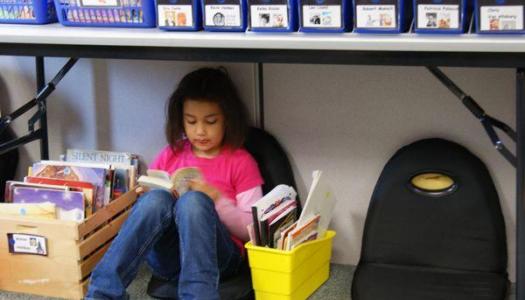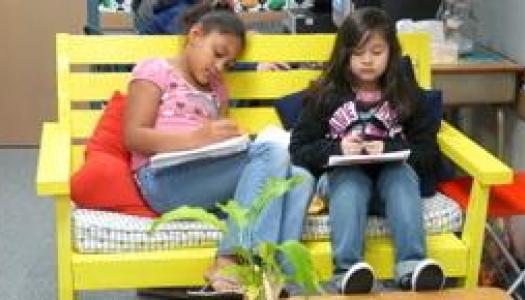Provide Sensory Experiences to Enhance Learning
Join Our Community
Access this resource now. Get up to three resources every month for free.
Choose from thousands of articles, lessons, guides, videos, and printables.
.jpg) It’s time to get away from it all—even for a few minutes. Envision yourself in a serene place. Spin around lightheartedly, taking in the wonder of it. Gaze at the shelves of beautiful books. Stroll around and hold interesting objects with different textures: some soft, others sleek, and a few woven. Listen to the hum of cheerful talk, trickling water from a tabletop fountain, and soft background music. Take in the fragrance of some lovely, colorful flowers or plants. Savor a piece of delicious fruit, or take a sip of cool water.
It’s time to get away from it all—even for a few minutes. Envision yourself in a serene place. Spin around lightheartedly, taking in the wonder of it. Gaze at the shelves of beautiful books. Stroll around and hold interesting objects with different textures: some soft, others sleek, and a few woven. Listen to the hum of cheerful talk, trickling water from a tabletop fountain, and soft background music. Take in the fragrance of some lovely, colorful flowers or plants. Savor a piece of delicious fruit, or take a sip of cool water.
Is this place like your classroom? It could be. There are some quick and easy ways to make your classroom a place where children can move and grow while engaging their senses.
Use classroom design to ensure that children can move freely in the room. Many classrooms are small, so think minimalist in terms of furniture you have in the classroom. Even if you are fortunate enough to have a large classroom, each and every piece of furniture should have a purpose. If it does not, donate it to another teacher or ask your school custodian to find a home for it.
- Decide on the best location for your gathering place. Choose well, because it is a very important part of classroom life. Remember that your gathering place is a very special location where children listen to stories, learn reading strategies, and share their thinking. In reality, it is the heart of the classroom—a place for engaging the brain and the body through different kinds of learning and activity.
- Focus student attention on the learning in your classroom. On the tops of bookshelves, display interesting books with appealing cover art that children cannot wait to read. Include pop-up books that invite readers to experience them. Feature a few new titles as often as you can. Designate wall space for attractive anchor charts that will guide students throughout the school year. (tactile/visual)
- Establish zones in your classroom where children can refresh and recharge. Even a very active child feels the need for quiet now and then. For students who need to experience calm, create a classroom meditation corner or garden. Ensure that the corner is peaceful and beautiful. Consider including some hardy plants, a tabletop fountain, a miniature Zen sandbox, or even a vase of fresh flowers from time to time. Although your space may be very limited, you can use a small round table or a stool covered with a tablecloth to create this simple kind of sanctuary. Space permitting, hang pictures of children, their families, and their pets for a gallery that will remind them of happy times. (auditory/kinesthetic/olfactory/visual)
- Set aside a small area where children can experience distinctive textures. Make available some soft blankets, stuffed animals, fabric squares of different textures such as velvet, suede, satin, and so on, or even decorative orbs that call to be held. Feel assured that these textures can be very comforting to some children, particularly barometer students. Offer younger children the chance to work with zippers, buckles, and buttons, too. In a very small classroom, you can readily store these items in a rolling cart or suitcase on wheels. (tactile)
- How will you fill your classroom with music? Whether you use a computer, radio, old-fashioned boom box, or other device, consider how and where you will play music. If you have a stand or table, you can house your equipment and display books with music-related themes or biographies of singers and musicians. From time to time, play classical music softly in the background as students work. Let them know that it is okay to stand, rock, or sway to the music, depending on their needs for movement. This might also be a logical place for your listening center, depending on your equipment and the logistics of your classroom. (auditory/kinesthetic)
- When everyone seems to need a movement break, turn up the volume on some lively music and invite all students to do some freestyle dancing. Or, play a waltz and have students pretend they are ice skating on a pond in your gathering place. If your space is carpeted, give children paper plates to place under their feet for a gliding motion as they “skate.” (auditory/kinesthetic)
- For a fun brain and body break, organize a march as children have fun with play instruments. This provides a chance for movement and helps with coordination. Store your play instruments in a large box decorated as a piano or a cylinder disguised as a drum. (auditory/kinesthetic/tactile)
- Do your students have rhythm or want to develop it? If so, teach children to snap their fingers so that they can engage their auditory and tactile senses. Show them how to create rhythmic patterns through snapping. Demonstrate how to play clapping games that provide helpful brain and body breaks. (auditory/kinesthetic/tactile)
- Encourage children to bring an apple, banana, or orange from home for a quick fruit break. (Be sure to check about food allergies.) Some children (and teachers!) get hungry during the school day, and this type of break provides a great opportunity for them to reenergize. Permit them to bring a water bottle as well. (olfactory/taste)
- Whenever you want children to transition, use chimes or another signal so that the sound calls but does not jar them. Look for a sound that serves as a distinctive yet gentle reminder that it is time to change tasks. Chimes, rain sticks, and xylophones are always popular choices. (auditory)
By creating a classroom environment that engages children through their senses, you will enable students to connect with their learning in meaningful ways. Each day, you will see them delight in the sights and sounds of a classroom especially designed with their growth and enjoyment in mind.








